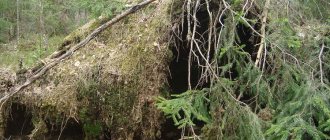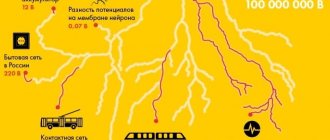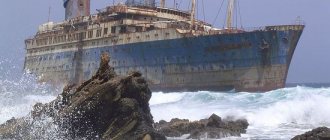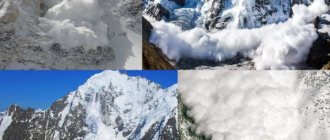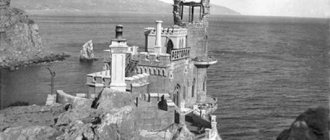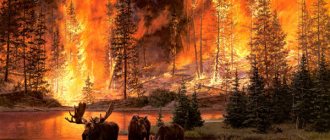Causes of avalanches.
The snow cover is heterogeneous. It accumulates on the slope in layers. Each of the layers is formed in a specific period and, as a rule, due to snowfall or wind transport, which redistributes previously fallen snow. Or due to snowfall and wind together (blizzard).
Also, new layers appear due to the formation of surface frost (analogous to dew, but in a frozen state). Under the influence of the sun (solation crusts). Or due to metamorphism of processes within the snow layer itself.
All scrap lying on the slope is affected by the force of gravity, which tries to move the snow down. As soon as in some particular place the force of gravity exceeds the force of resistance, destruction occurs, which, under certain conditions, begins to spread in all directions.
Primary destruction, as a rule, occurs not in the thickness of any main layer, but at the boundary of the layers (“weak layer”). Moreover, the destruction of the “weak layer” is a shear failure. Only after the destruction of the weak layer does the “cutting out” of the “board” from the snow slope occur. The characteristic sound of “wumps” or “uh” and sometimes a noticeable subsidence is the destruction of the weak layer.
Deadly snow cloud
An avalanche is formed by snow, ice and rocks after they begin to slide down steep mountain slopes at an ever-increasing speed (from 20 to 1000 m/s), capturing new portions of snow and ice, increasing their volume. Considering that the impact force of the elements often amounts to tens of tons per square meter, an avalanche sweeps away everything in its path. It stops only at the bottom, having reached gentle sections of the slope or finding itself at the bottom of the valley.
Avalanches form only in those parts of the mountain where there are no forests, the trees of which could slow down and prevent the snow from gaining the required speed.
The snow cover begins to move after the thickness of the freshly fallen snow begins to be at least thirty centimeters (or the layer of old snow exceeds seventy), and the steepness of the mountain slope ranges from fifteen to forty-five degrees. If the layer of fresh snow is about half a meter, the probability of snow melting in 10-12 hours is incredibly high.
Secrets of the Bermuda Triangle63794.3982
It is impossible not to mention the role of old snow in the formation of avalanches in the mountains. It forms an underlying surface that allows freshly fallen precipitation to slide over it unhindered: old snow fills all the unevenness of the soil, bends bushes to the ground, forming a perfectly smooth surface (the larger its layer, the fewer rough obstacles that can stop the snow from falling).
The most dangerous periods when snow falls occur are considered to be winter and spring (about 95% of cases are recorded at this time). A snowfall is possible at any time of the day, but more often this event occurs during the day. The occurrence of landslides and avalanches is primarily influenced by:
- Snowfall or concentration of huge amounts of snow on mountain slopes;
- Weak adhesive force between new snow and the underlying surface;
- Warming and rain, resulting in the formation of a slippery layer between snow precipitation and the underlying surface;
- Earthquakes;
- A sudden change in temperature (sharp cooling after unexpected warming, which makes it possible for fresh snow to slide comfortably over the formed ice);
- Acoustic, mechanical and wind effects (sometimes a scream or clap is enough to set the snow in motion).
Sweeping everything out of the way
Freshly fallen snow precipitation is held on the slope due to the friction force, the magnitude of which depends primarily on the angle of the slope and the moisture content of the snow. A collapse begins when the pressure of the snow mass begins to exceed the force of friction, resulting in the snow coming into a state of unstable equilibrium.
As soon as the avalanche begins to move, a pre-avalanche air wave is formed, which clears the path for the avalanche, destroying buildings, filling up roads and paths.
Before a snowfall occurs, a dull sound is heard high in the mountains, after which a huge cloud of snow rushes down from the top at high speed, taking with it everything that comes in its way. It rushes without stopping, gradually picking up pace, and stops no sooner than it reaches the bottom of the valley. After this, a huge layer of snow dust shoots high into the sky, forming a continuous fog. When the snow dust falls, dense piles of snow open before your eyes, in the middle of which you can see branches, remains of trees, and boulders.
Classifications of snow avalanches.
There are quite a large number of classifications of snow avalanches. However, the basic ones are:
Classification by type. Classification by size.
At the same time, the classification of snow avalanches by their type is the most common in the world. It divides all snow avalanches according to the type of avalanche into:
Snow avalanches from the line (“boards”). Snow avalanches from a point.
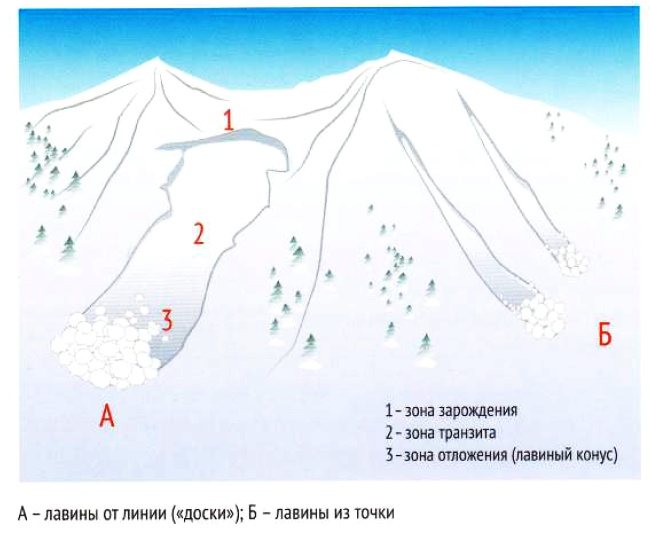
The influence of snowfalls on avalanches.
An increase in the thickness of the snow cover leads to added load on the snow layer and an increase in stress in it. It is believed that if more than 30 cm of fresh snow falls per day, the likelihood of natural avalanches increases significantly.
It is not just the amount of snow that is important, but also the speed at which it falls. The higher it is, the greater the likelihood of a bad avalanche situation developing. The critical threshold is considered to be snowfall at a speed of 1.5-2 cm/hour or more.
Thus, it is necessary to take into account both the total amount of snow that fell in the last 24 hours and the rate of snowfall. Especially at peak times. 20 cm of snow that falls in a few hours can be more dangerous than 1 meter of snow that falls evenly over 3 days.
Victim statistics
On average, about 350 people die from avalanches every year. Of these, about 20 people are from Russia. The list also includes people who died from falling snow from artificial slopes - roofs and eaves. Indicators may change in some years after natural disasters with a large number of casualties.
Avalanche statistics show that in the first half of the 20th century, snow disasters more often overtook their victims on highways and in homes. Today, the majority of those killed by avalanches are tourists and athletes in the mountains. Tourists often go to the mountains during a dangerous period of avalanches. One of the main mistakes is that they are in dangerous territory without a guide. In 2007, an avalanche overtook a group of tourists in China.
Extreme skiing sports, which involve traveling along wild routes, are gaining great popularity. There are no camp sites or cable cars on their way; there you can admire the scenery and ride on untouched snow. This includes:
- freeride;
- ski tour;
- backcountry.
In addition, many people are interested in mountaineering, snowmobile riding and snowboarding. Avalanche statistics show that tourists most often die from disasters. The table shows the percentage of people dying from snow disasters:
| A country | Snowmobilists (%) | Skiers (%) | Climbers (%) | Locals (%) |
| USA | 35 | 25 | 23 | 17 |
| Canada | 20 | 43 | 14 | 23 |
Data on mortality from snow disasters in Europe:
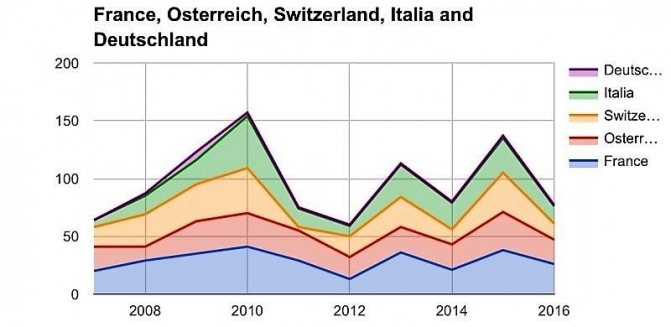
Often such hikes take place in areas that pose an avalanche risk or are not serviced by avalanche services. Some tourists do not pay much attention to signs about possible snow falling from the mountains and ski down dangerous slopes. There are numerous examples of avalanches causing casualties in such areas. For example, in March 2020, an avalanche from Mount Cheget in the Elbrus region killed seven Russian tourists.
Avalanches at resorts are unlikely - to protect vacationers, specialists take all possible avalanche safety measures.
In Russia, avalanches are possible in all mountain regions. The first place in terms of avalanches is the Caucasus. Then the Kamchatka Peninsula, Western and Eastern Siberia, the Urals. According to the research laboratory at Moscow State University. Lomonosov, more than 6 million people live in avalanche-prone and potentially dangerous areas throughout the country. The map shows avalanche locations in Russia:
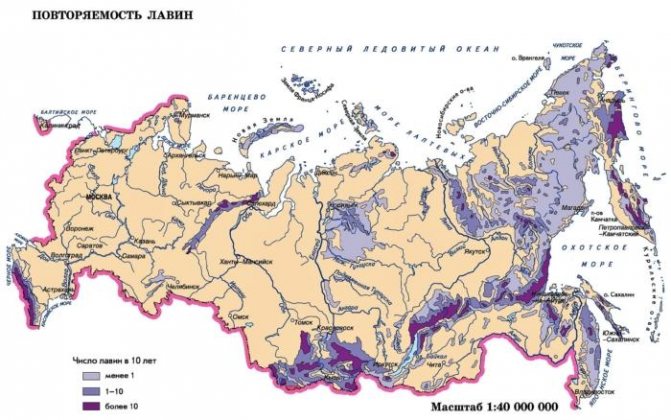
Avalanche statistics for the period from 2008 to 2020:
| 2008 | |||||||||||||
| Afghanistan, Badashkhan | December | 70 dead | |||||||||||
| France, Mont Blanc | August | 16 dead | |||||||||||
| Pakistan, Chitral | April | more than 40 victims | |||||||||||
| year 2009 | |||||||||||||
| Türkiye, Gumushane | January | 11 dead | |||||||||||
| Afghanistan, Salang pass | January | 10 victims | |||||||||||
| 2010 | |||||||||||||
| Afghanistan, Salang pass | February | about 200 victims | |||||||||||
| Afghanistan, Badashkhan | March | 35 victims | |||||||||||
| Russia, Kamchatka | April | 10 dead | |||||||||||
| Pakistan, Barago Serai | February | 147 victims | |||||||||||
| Pakistan | February | 19 dead | |||||||||||
| 2011 | |||||||||||||
| Afghanistan, Daikundi | February | 21 dead | |||||||||||
| year 2012 | |||||||||||||
| Afghanistan, Nasi | March | about 20 victims | |||||||||||
| Afghanistan, Dusty | March | about 60 dead | |||||||||||
| Pakistan, Gayari base | April | 138 dead | |||||||||||
| Nepal, Manaslu | September | 15 victims | |||||||||||
| Afghanistan, Badakhshan | January | 46 dead | |||||||||||
| India | February | 19 victims | |||||||||||
| year 2014 | |||||||||||||
| Nepal, Everest | April | 25 dead | |||||||||||
| Nepal, Annapurna | October | 43 victims | |||||||||||
| 2015 | |||||||||||||
| Nepal, Everest | April | 24 victims | |||||||||||
| Afghanistan (northeast) | February | 310 dead | |||||||||||
| 2017 | |||||||||||||
| Italy, Abruzzo | January | about 30 dead | |||||||||||
| Russia, Kabardino-Balkaria | March | 7 dead | |||||||||||
| 2018 | |||||||||||||
| Türkiye, Bitlis province | January | 5 dead | |||||||||||
| Himalayas | October | 9 victims | |||||||||||
| 2019 | |||||||||||||
| Russia, Sochi | January | 2 victims | |||||||||||
| India, Ladakh | november | 6 dead | |||||||||||
| 2020 | |||||||||||||
| Pakistan, Azad Kashmir | January | 57 dead | |||||||||||
| Türkiye, Van province | February | 33 dead | |||||||||||
The influence of wind on snow avalanches.
The wind is capable of moving significant masses of snow. And the higher its speed, the greater its transporting ability. Even after a light snowfall, if accompanied by strong winds, avalanche danger may occur on leeward slopes, since a critical mass of snow can accumulate there. Constant monitoring of wind transfer and its signs (eaves, sastrugi, “snow flags”, cushions of shadow zones, granular frost on vertical objects, etc.) is necessary.
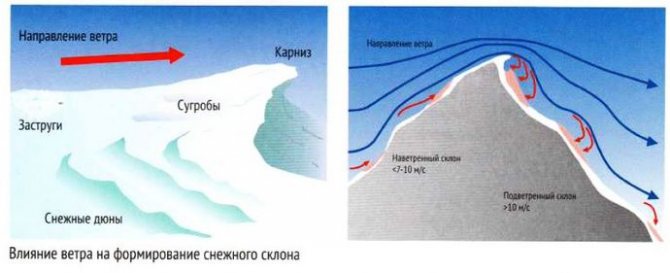
The threshold wind value at which strong wind transfer begins on the familiar alpine terrain is 5-7 m/s. But in the foothills and mid-mountains it begins at a speed of 3-4 m/s.
Safety precautions
To avoid death and not to be buried under a thick layer of snow, every person going to the mountains on vacation while there is snow there must learn the basic rules of behavior when a deadly stream descends.
If an avalanche warning has been announced during your stay at the base, it is advisable to refrain from hiking in the mountains. If there was no warning, then before leaving the base and hitting the road, you need to take into account the forecast of the risk of snow melting, as well as find out as much as possible about the mountains in which the risk of avalanches is maximum and avoid dangerous slopes (this simple rule of behavior is quite capable of saving life).
If heavy snowfalls were recorded before going to the mountains, it is better to postpone the hike for two or three days and wait for the snow to fall, and if there are no avalanches, wait until it settles. It is also very important not to go to the mountains alone or together: it is advisable to stay in a group. This will always provide avalanche insurance, for example, if the group members are tied with avalanche tape, this will make it possible to detect a companion covered in snow.
Before going out into the mountains, it is advisable to take with you an avalanche transceiver, which will make it possible to find a person caught in an avalanche.
It is very important not to forget to take your mobile phone with you (it has already saved more than one person’s life). It is also a good idea to take special avalanche backpacks, which have a system of inflatable cushions that make it possible for a person caught in an avalanche to “float up”.
In the mountains you need to move only along roads and paved paths of valleys and along mountain ridges, and it is very important to remember that you cannot drive onto steep snow-covered slopes, cross them across them, or move in a zigzag. It is also forbidden to step on snow cornices, which are accumulations of dense snow in the form of a canopy on the leeward side of a sharp ridge (they may well collapse suddenly and cause an avalanche).
If it is not possible to go around a steep slope, before overcoming it, you need to make sure that the snow cover is stable. If it begins to sink under your feet and begins to make a hissing sound, you need to go back and look for another road: the likelihood of an avalanche is high.
The influence of temperature on snow avalanches.
The influence of temperature on snow cover and, accordingly, on the avalanche situation is very diverse. For convenience, there are 5 main temperature scenarios, which are regularly repeated during the winter.
Strong rapid warming. Crossing 0 degrees sharply increases avalanche danger. Slow moderate warming, without crossing 0 degrees, gives stabilization. Gradual warming during the day and cooling at night are signs of stabilization. Cold weather causes the process of preservation of the conditions that existed, or their gradual deterioration. A long frosty period leads to the formation of weak layers.
The influence of solar radiation on snow avalanches.
In general, if we talk about the winter period, the sun has a stabilizing effect by reducing the average daily temperature gradient in the snow mass and triggering the process of metamorphism such as the rounding of snow crystals. The previously formed deep frost and a number of other weak layers, while maintaining sunny weather with near-zero air temperatures, can change over time and sometimes even disappear altogether.
But as soon as the temperature of the surface layer of snow passes through zero due to solar heating, the situation will change dramatically. That is why in the spring, when the influence of the sun is especially strong, avalanche conditions can change in tens of minutes.
